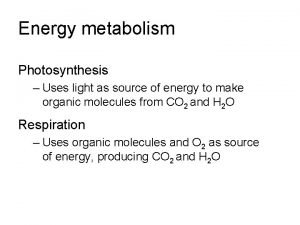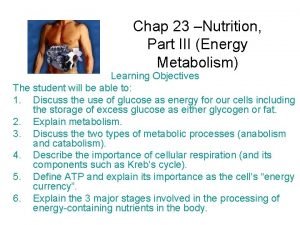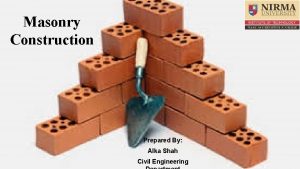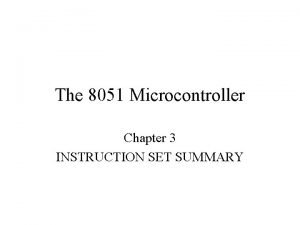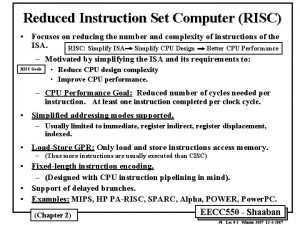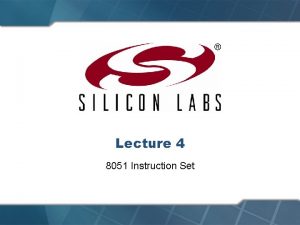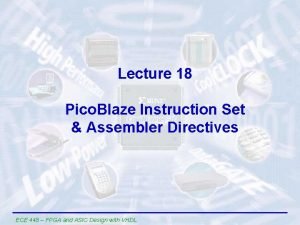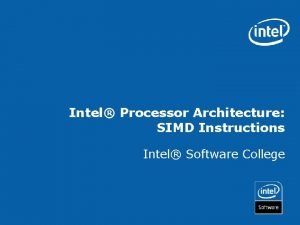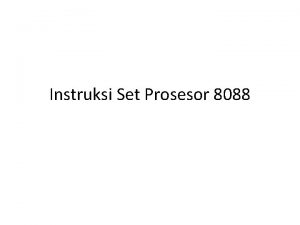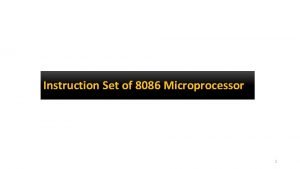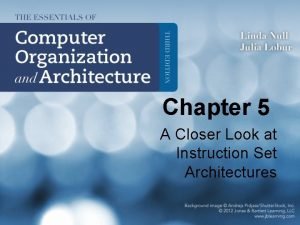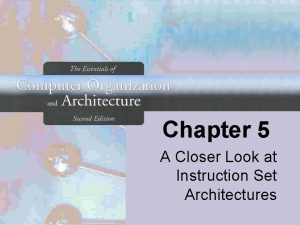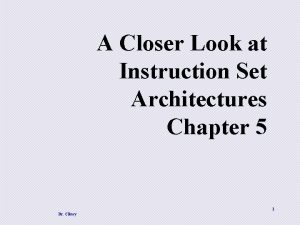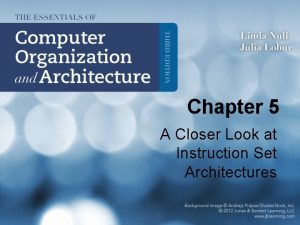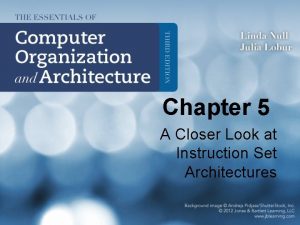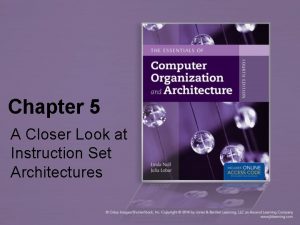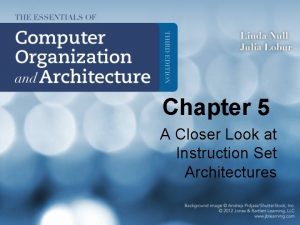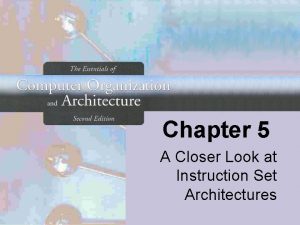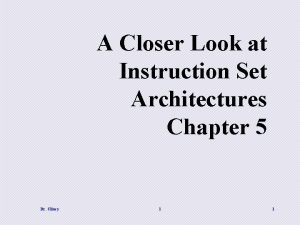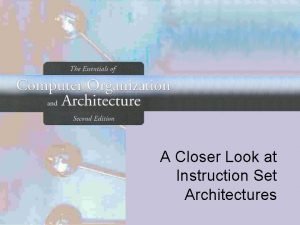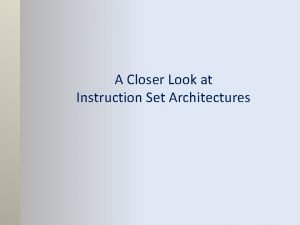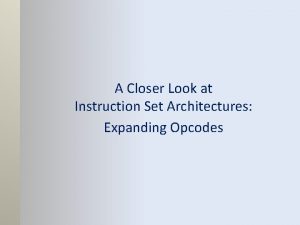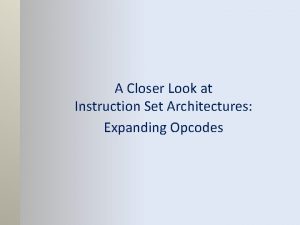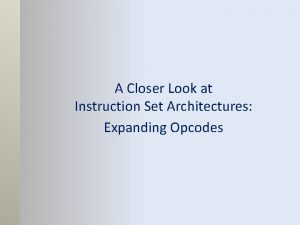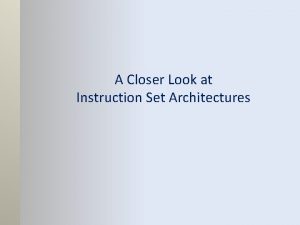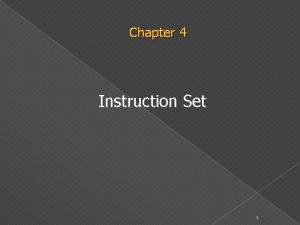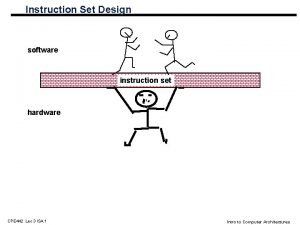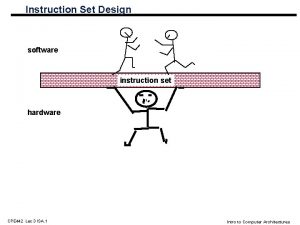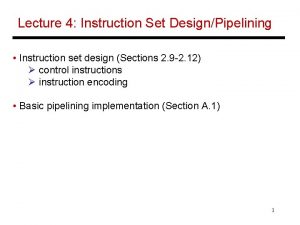Chapter 5 A Closer Look at Instruction Set





































- Slides: 37

Chapter 5 A Closer Look at Instruction Set Architectures

5. 2 Instruction Formats In designing an instruction set, consideration is given to: • Instruction length. – Whether short, long, or variable. • Number of operands. • Number of addressable registers. • Memory organization. – Whether byte- or word addressable. • Addressing modes. – Choose any or all: direct, indirect or indexed. 2

5. 2 Instruction Formats • Byte ordering, ( endianness), is another major architectural consideration. • If we have a two-byte integer, the integer may be stored so that the least significant byte is followed by the most significant byte or vice versa. 3

Big endian – Big endian machines store the most significant byte first (at the lower address). 4

Little Endian In little endian machines, the least significant byte is followed by the most significant byte. 5

Example • Show the big endian and small endian arrangements of the bytes in 12345678 16 6

Internal Storage in the CPU • We have three choices 1. A stack architecture 2. An accumulator architecture 3. A general purpose register architecture. • In choosing one over the other, the tradeoffs are simplicity and cost of hardware design with execution speed and ease of use. 7

5. 2 Instruction Formats • Stack architecture, instructions and operands are implicitly taken from the stack. – A stack cannot be accessed randomly. • Accumulator architecture – one operand of a binary operation is implicitly in the accumulator. – One operand is in memory, creating lots of bus traffic. • General purpose register (GPR) architecture, registers can be used instead of memory. – Faster than accumulator architecture. – Efficient implementation for compilers. – Results in longer instructions. 8

5. 2 Instruction Formats • Most systems today are GPR systems. • There are three types: – Memory-memory where two or three operands may be in memory. – Register-memory where at least one operand must be in a register – Load-store where no operands may be in memory. • The number of operands and the number of available registers has a direct affect on instruction length. 9

Stack architecture • Stack machines use one - and zero-operand instructions. • LOAD and STORE instructions require a single memory address operand. • Other instructions use operands from the stack implicitly. • PUSH and POP operations involve only the stack’s top element • Binary instructions (e. g. , ADD, MULT) use the top two items on the stack. 10

Stack architecture • Stack architectures require us to think about arithmetic expressions a little differently. • We are accustomed to writing expressions using infix notation – such as: Z = X + Y • Stack arithmetic requires that we use postfix notation Z = XY+ • This is also called reverse Polish notation, (somewhat) in honor of its Polish inventor, Jan Lukasiewicz (1878 1956). 11

Stack architecture • The principal advantage of postfix notation is that parentheses are not used. • For example, the infix expression, Z = (X Y) + (W U), becomes: Z = X Y W U + in postfix notation 12

Stack architecture • In a stack ISA, the postfix expression, Z=XY WU + might look like this: PUSH X PUSH Y MULT PUSH W PUSH U MULT ADD PUSH Z Note: The result of a binary operation is implicitly stored on the top of the stack! 13

5. 2 Instruction Formats • In a one-address ISA, like MARIE, the infix expression, Z = X Y + W U looks like this: LOAD X MULT Y STORE TEMP LOAD W MULT U ADD TEMP STORE Z 14

5. 2 Instruction Formats • In a two-address ISA, (e. g. , Intel, Motorola), the infix expression, Z = X Y + W U might look like this: LOAD R 1, X MULT R 1, Y LOAD R 2, W MULT R 2, U ADD R 1, R 2 STORE Z, R 1 Note: One-address ISAs usually require one operand to be a register. 15

5. 2 Instruction Formats • With a three-address ISA, (e. g. , mainframes), the infix expression, Z = X Y + W U might look like this: MULT R 1, X, Y MULT R 2, W, U ADD Z, R 1, R 2 Would this program execute faster than the corresponding (longer) program that we saw in the stack-based ISA? 16

1, 2 and 3 Operand Examples Instruction SUB Y, A, B MPY T, D, E ADD T, T, C DIV Y, Y, T Comment Y A–B T D*E T T+C Y Y/T Using three addresses Instruction MOVE Y, A SUB Y, B MOVE T, D MPY T, E ADD T, C DIV Y, T Comment Y A Y Y–B T D T T*E T T+C Y Y/T Using two addresses See pages 206 -207 for another example Instruction LOAD D MPY E ADD C STOR Y LOAD A SUB B DIV Y STOR Y Comment AC D * E AC + C Y AC AC AC – B AC / Y Y AC Using one address Here we compare the length of code if we have one address instructions, two address instructions and three address instructions, each computes Y = (A – B) / (C + D * E) Notice: one and two address operand instructions 17 write over a source operand, thus destroying data

5. 2 Instruction Formats • We have seen how instruction length is affected by the number of operands supported by the ISA. • In any instruction set, not all instructions require the same number of operands. • Operations that require no operands, such as HALT, necessarily waste some space when fixed-length instructions are used. • One way to recover some of this space is to use expanding opcodes. 18

5. 2 Instruction Formats q A system has 16 registers and 4 K of memory q We need 4 bits to access one of the registers. q We also need 12 bits for a memory address q If the system is to have 16 -bit instructions, instructions we have two choices for our instructions: 19

5. 2 Instruction Formats • If we allow the length of the opcode to vary, we could create a very rich instruction set: Is there something missing from this instruction set? 20

5. 3 Instruction types Instructions fall into several broad categories that you should be familiar with: • Data movement. • Arithmetic. • Boolean. • Bit manipulation. • I/O. • Control transfer. • Special purpose. 21

5. 4 Addressing • Addressing modes specify where an operand is located. • They can specify a – Constant – Register – memory location. • The actual location of an operand is its effective address • Certain addressing modes allow us to determine the address of an operand dynamically. 22

5. 4 Addressing • Immediate addressing – is where the data is part of the instruction. • Direct addressing – is where the address of the data is given in the instruction. • Register addressing – is where the data is located in a register. • Indirect addressing – gives the address of the data in the instruction. • Register indirect addressing – uses a register to store the address of the data. 23

5. 4 Addressing • Indexed addressing ( E. A = R + address in operand) – uses a register as an offset, which is added to the address in the operand to determine the effective address of the data. • Based addressing – is similar except that a base register is used instead of an index register • The difference between these two is that an – index register holds an offset relative to the address given in the instruction – a base register holds a base address where the address field represents a displacement from this base. • Stack addressing – the operand is assumed to be on top of the stack. 24

5. 4 Addressing • For the instruction shown, what value is loaded into the accumulator for each addressing mode? 25

5. 4 Addressing • These are the values loaded into the accumulator for each addressing mode. 26

5. 5 Instruction-Level Pipelining • Some CPUs divide the fetch-decode-execute cycle into smaller steps. • These smaller steps can often be executed in parallel to increase throughput. • Such parallel execution is called instruction-level pipelining • This term is sometimes abbreviated ILP in the literature. 27

5. 5 Instruction-Level Pipelining • Suppose a fetch-decode-execute cycle were broken into the following smaller steps: 1. Fetch instruction. 2. Decode opcode. 3. Calculate effective address of operands. 4. Fetch operands. 5. Execute instruction. 6. Store result. • Suppose we have a six-stage pipeline. S 1 fetches the instruction, S 2 decodes it, S 3 determines the address of the operands, S 4 fetches them, S 5 executes the instruction, and S 6 stores the result. 28

5. 5 Instruction-Level Pipelining • For every clock cycle, one small step is carried out, and the stages are overlapped. S 1. Fetch instruction. S 2. Decode opcode. S 3. Calculate effective address of operands. S 4. Fetch operands. S 5. Execute. S 6. Store result. 29

theoretical speedup offered by a pipeline K = # of stages/ instruction tp = time / stage. Each instruction represents a task in the pipeline. n = # of tasks (instructions) • 1 st task (instruction) requires k tp , to complete in a k-stage pipeline. • The remaining (n - 1) tasks • Total time to complete the remaining tasks = (n - 1)tp. Thus, to complete n tasks using a k-stage pipeline requires (k tp) + (n - 1)tp = (k + n - 1)tp. 30

5. 5 Instruction-Level Pipelining • If we take the time required to complete n tasks without a pipeline and divide it by the time it takes to complete n tasks using a pipeline, we find: • If we take the limit as n approaches infinity, (k + n - 1) approaches n, which results in a theoretical speedup of: 31

5. 5 Instruction-Level Pipelining • Our equations take a number of things for granted –First we have to assume that the architecture supports fetching instructions and data in parallel. –Second we assume that the pipeline can be kept filled at all times. This is not always the case. Pipeline hazards arise that cause pipeline conflicts and stalls – Resource conflicts. – Data dependencies. – Conditional branching 32

5. 6 Real-World Examples of ISAs • Intel introduced pipelining to their processor line with its Pentium chip. • The first Pentium had two five-stage pipelines • Each subsequent Pentium processor had a longer pipeline than its predecessor with the Pentium 4 having a 24 -stage pipeline. • The Itanium (IA-64) has only a 10 -stage pipeline. • Intel processors support a wide array of addressing modes. • The Itanium, having a RISC core, supports only one: register indirect addressing with optional post increment 33

MIPS Example of ISAs • MIPS ( Microprocessor Without Interlocked Pipeline Stages). • The architecture is –little endian –word-addressable with three-address –fixed-length instructions. • Pipeline size of the MIPS processors has grown –R 2000 and R 3000 have five-stage pipelines –R 4000 and R 4400 have 8 -stage pipelines. –R 10000 has three pipelines • A five-stage pipeline for integer instructions • a seven-stage pipeline for floating-point instructions • a six-state pipeline for LOAD/STORE instructions. 34

JVM Example of ISAs • The Java programming language is an interpreted language that runs in a software machine called the Java Virtual Machine (JVM). • A JVM is written in a native language for a wide array of processors, including MIPS and Intel. • Like a real machine, the JVM has an ISA all of its own, called bytecode. • This ISA was designed to be compatible with the architecture of any machine on which the JVM is running. 35

5. 6 Real-World Examples of ISAs 36

5. 6 Real-World Examples of ISAs • Java bytecode is a stack-based language. • Most instructions are zero address instructions. • The JVM has four registers that provide access to five regions of main memory. • All references to memory are offsets from these registers. Java uses no pointers or absolute memory references. • Java was designed for platform interoperability, not performance! 37
 Look up look down look all around
Look up look down look all around Chapter 7 a closer look energy metabolism pathways
Chapter 7 a closer look energy metabolism pathways Chapter 7 a closer look energy metabolism pathways
Chapter 7 a closer look energy metabolism pathways A closer look at thanksgiving
A closer look at thanksgiving Look closer see me
Look closer see me Metaphase ii
Metaphase ii Total set awareness set consideration set
Total set awareness set consideration set Training set validation set test set
Training set validation set test set Differentiated instruction vs individualized instruction
Differentiated instruction vs individualized instruction Site:slidetodoc.com
Site:slidetodoc.com One day closer quotes
One day closer quotes Closer tactical relationship in procurement
Closer tactical relationship in procurement God is closer than you think
God is closer than you think Double flemish bond in brick masonry
Double flemish bond in brick masonry Which electrode is positive
Which electrode is positive Sent interrupter ence
Sent interrupter ence Care closer to home
Care closer to home Care closer to home
Care closer to home Care closer to home
Care closer to home Toothing and racking back
Toothing and racking back Creeping closer meaning
Creeping closer meaning Lexair collet closer
Lexair collet closer Friend that sticks closer than a brother esv
Friend that sticks closer than a brother esv Jesus draw me close
Jesus draw me close Classify instruction set of 8086
Classify instruction set of 8086 Lmc little man computer
Lmc little man computer Instruction set of 8051
Instruction set of 8051 What are the two versions of sic?
What are the two versions of sic? Contoh soal set instruksi 3 alamat
Contoh soal set instruksi 3 alamat Risc instruction set example
Risc instruction set example Marie computer architecture
Marie computer architecture Ljmp instruction in 8051 example
Ljmp instruction in 8051 example Picoblaze instruction set
Picoblaze instruction set Intel simd instruction set
Intel simd instruction set 8088 instruction set
8088 instruction set Instructions set of 8086 microprocessor
Instructions set of 8086 microprocessor Classify instruction set of 8086
Classify instruction set of 8086 Isa in architecture
Isa in architecture

